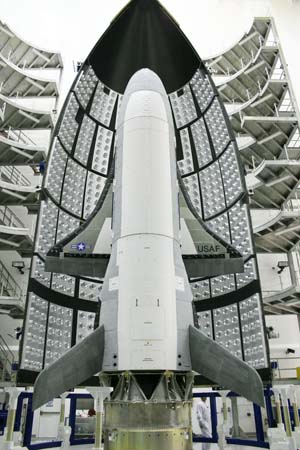X-37: Ready for Launch
On Thursday, April 22, the U.S. Air Force will finally launch its little, unmanned X-37 orbital spaceplane on top of an Atlas V rocket. The liftoff, which will take place in a window between 7:52 p.m. and 8:01 p.m., will mark the culmination of years of development for the newest U.S. spacecraft—an…
On Thursday, April 22, the U.S. Air Force will finally launch its little, unmanned X-37 orbital spaceplane on top of an Atlas V rocket. The liftoff, which will take place in a window between 7:52 p.m. and 8:01 p.m., will mark the culmination of years of development for the newest U.S. spacecraft—and the world's only reusable one after the space shuttle's planned retirement toward the end of this year.
The X-37 program, which is run by the Air Force's Rapid Capabilities Office, has been veiled in secrecy ever since NASA handed the program off to the Defense Advance Research Projects Agency and the Air Force several years ago. The spaceplane's mission remains a mystery, although deployment of small satellites and space experiments, and their later retrieval and return, have been mentioned as possible activities once the X-37 becomes operational.

On April 20, Gary Payton, Deputy Under Secretary of the Air Force, gave a few details about the program in a teleconference. One new piece of information is that the Air Force will analyze the procedures on the ground after the spacecraft comes home to get a sense of how feasible and affordable it will be to turn the X-37 around for another flight within a matter of days or weeks. "If we were in a surge environment where we were putting up a whole bunch of satellites all at once, over the course of a month or two, kinda like an operationally responsive space scenario...I would like to see this X-37 handled much more like an airplane, maybe an SR-71," he said. "I don't think we've set any specific goal, but I would think handling this bird more like an SR-71 and less like a routine space launch vehicle would be a good objective. So that's measured in several days, or maybe 10-15 days, or less. Something like that."
Payton also revealed that the program has a contract for a second "tail number," or a second X-37, which will make its first flight at some point in 2011. While the first tail number's duration in orbit on its inaugural flight hasn't been released, Payton did confirm that the spaceplane, which can stay in orbit for up to 270 days, will make a landing before the second tail number ever flies, to ensure that any improvements would be applied to the second tail number's first flight.
When asked to come up with a good adjective for the X-37 with regard to the vehicle's revolutionary nature, Payton replied.
"Oh, wow. No, don't use 'Oh, wow.' I'm an engineer, not an English major."
For an audio file of the teleconference, click here.
The X-37 program, which is run by the Air Force's Rapid Capabilities Office, has been veiled in secrecy ever since NASA handed the program off to the Defense Advance Research Projects Agency and the Air Force several years ago. The spaceplane's mission remains a mystery, although deployment of small satellites and space experiments, and their later retrieval and return, have been mentioned as possible activities once the X-37 becomes operational.

On April 20, Gary Payton, Deputy Under Secretary of the Air Force, gave a few details about the program in a teleconference. One new piece of information is that the Air Force will analyze the procedures on the ground after the spacecraft comes home to get a sense of how feasible and affordable it will be to turn the X-37 around for another flight within a matter of days or weeks. "If we were in a surge environment where we were putting up a whole bunch of satellites all at once, over the course of a month or two, kinda like an operationally responsive space scenario...I would like to see this X-37 handled much more like an airplane, maybe an SR-71," he said. "I don't think we've set any specific goal, but I would think handling this bird more like an SR-71 and less like a routine space launch vehicle would be a good objective. So that's measured in several days, or maybe 10-15 days, or less. Something like that."
Payton also revealed that the program has a contract for a second "tail number," or a second X-37, which will make its first flight at some point in 2011. While the first tail number's duration in orbit on its inaugural flight hasn't been released, Payton did confirm that the spaceplane, which can stay in orbit for up to 270 days, will make a landing before the second tail number ever flies, to ensure that any improvements would be applied to the second tail number's first flight.
When asked to come up with a good adjective for the X-37 with regard to the vehicle's revolutionary nature, Payton replied.
"Oh, wow. No, don't use 'Oh, wow.' I'm an engineer, not an English major."
For an audio file of the teleconference, click here.